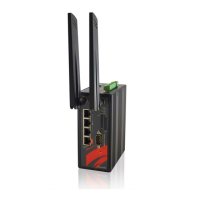3.6.3 LAN > VLAN
This section allows you to set up VLAN that provides a network segmentation system to
distinguish the LAN clients and separate them into different LAN subnet for enhancing security
and controlling traffic.
For 3-port LANs, the VLAN Mode allows you to select Off, Tag Base (802.1p) or Port Base.
When VLAN Mode is set to Tag Base, the VLAN setting window will appear as shown below.
For each row, the settings can be enabled or disabled by checkbox and select the Subnet and
the VLAN ID (VID). The Subnet sets up the IP address and IP mask for the router so this router
can communicate with the third party by this IP address and IP mask on this VLAN. (Note: The
NET1 can’t remove it and fixes in the first column.)
Furthermore, the Subnet provides DHCP Server function to allow the third party for the same
VLAN to get IP address and IP mask. Therefore, you do not need to configure manually.
(Note: The subnet information will show the Subnet window from the LAN catalogue.)
There are three ports for Tag Base Mode, including LAN1, LAN2 and LAN3. And one Router
port which is a gate allows those ports to access internet or the router. The PVID and Tag
Mode are for LAN1, LAN2 and LAN3 ports. The PVID provides the untagged devices to
communicate with third-party devices. (Note: The untagged devices mean not to support
802.1p VLANs.)
The Tag Mode can be Trunk or Access. The Trunk allows to carry multiple 802.1p VLANs
traffic. The Access allows the untagged devices to communicate with a specific 802.1p VLAN
by assigned PVID.

